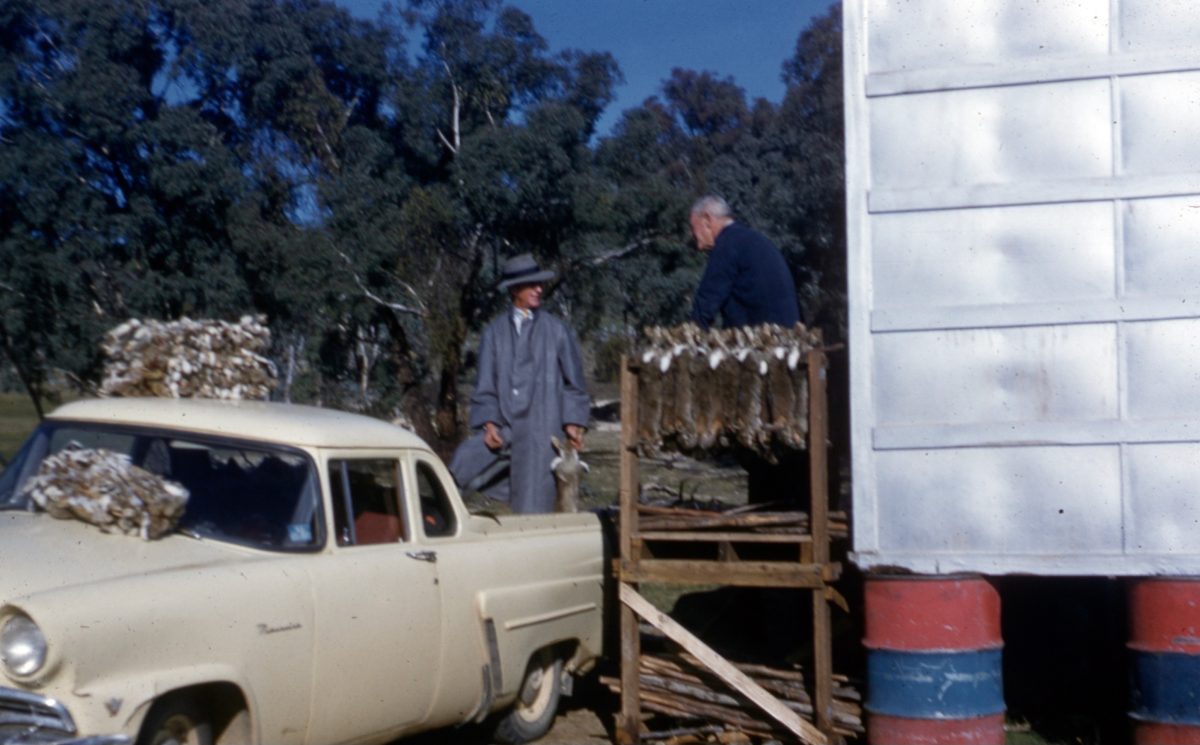
Golspie soldier settler David Thompson (left, closest to vehicle) and two colleagues prepare rabbits for the freezer. His son Stewart, then aged about 4, is in the foreground. Photo: Thompson family collection.
At the peak of Australia’s rabbit plague, the introduced rodents were so thick it seemed an entire hill or paddock moved when they scattered. While devastating for pastures, they generated plenty of income for trappers and enterprising businessmen who set up freezers.
Aged 4 in the late 1950s at Golspie, near Taralga, when his father was clearing rabbits from his solder-settler’s block, Stewart Thompson recalls loads of the pest being delivered to the Peelwood rabbit freezer north of Crookwell twice a week.
“Dad’s method was to find where all the burrows were, then fence that paddock out and just concentrate on the rabbit burrows,” Stewart said. “Then when he got that paddock cleared, they would go and fence another paddock and clear that.”
This was about a century after rabbits were introduced in Australia. On Christmas Day 1859, Thomas Austin, a self-made wealthy settler, released 13 European wild rabbits on his estate, Winchelsea, Barwon Park, so they could be hunted for sport, according to the Australian National Museum. It did not take long for them to spread north and by 1916, newspaper records recount trappers in sulkies delivering large numbers to Peelwood, from where another courier would take them to Crookwell.

David Thompson with his Ford Customline ute delivering rabbits to the freezer at Peelwood. The Thompsons made two trips a week to Peelwood. The man taking delivery is thought to be Herb Fardy, although Stewart Thompson is unsure of the name. Photo: Thompson family collection.
In 1922, the Peelwood correspondent for the Goulburn Evening Penny Post said the enormous numbers of rabbits came about because of about 25 miles (40 km) of Abercrombie range country that was Crown land – fit only for rabbit breeding – running parallel to numerous land holdings.
“If the Government does not take some steps to do away with the pest in the mountains the landholders in question will always have a double share of bunnies to contend with,” the correspondent said. One landholder had shot 1400 in one day, and expected to reach 14,000 by the time he cleared his run.
History Goulburn volunteer Pat Rice said her father Bill Gray worked on the Kensit property at Narrawa, west of Crookwell, in the 1940s, dealing with plague rabbits. Alongside other workers and dogs, they would herd hundreds of rabbits into a corner of a paddock enclosed with wire netting fence and destroy them.
“Dad earned enough money from rabbits to buy Nanna her first Kelvinator fridge,” Pat said. She said dried skins had come in handy when she was a girl staying at Crookwell in the cold weather. She would slip them onto her feet at night to ward off the chill.

Large freezing works were built near Crookwell Railway Station about 1909. Over the years, tonnes of rabbit meat was exported from Crookwell to England. This photo was taken in 1941. Photo: State Library of NSW.
In Lilac City – The Story of Goulburn, author William Bayley says rabbits arrived in the local area about 1905, although the Penny Post reports much earlier, in 1896, an orchardist’s fox terrier unearthing a burrow full of six little rabbits.
“The discovery has caused orchardists and others considerable alarm,” the paper reported. “Special efforts should be made to exterminate the pest before it gets a firm hold.”
Of course, rabbits prevailed despite organised drives of men with dogs flushing them from undergrowth and shooting them, poisoning them with carrots laced with strychnine, trapping and sending ferrets down burrows.
Returns for rabbit skins caused industrial action at the huge Bungendore freezers, where 50 trappers met in 1910 and threatened to stop supplies unless they received more for each pair.
In Memories of Goulburn – oral history recorded & collated by Heather West and Lynette Brown, John Dixon recounts trapping rabbits on the eastern side of Rocky Hill and selling the skins, which fetched one pound for eight of them.
“Our family ate rabbit, as it was the only meat we had. Times were tough,” John said.

A truckload of rabbits off to the freezer. Photo: National Museum of Australia.
In 1936, the Penny Post reported that three men in Goulburn were charged with stealing rabbit skins and appeared in court. The report indicated they likely stole from one skin merchant, Patrick Callaghan, and sold to another merchant, H R Hancock. One of the men who pleaded guilty was jailed for three months, one received a month’s sentence and the other was remanded to appear later. Rabbits weren’t only a scourge on the land, but this case showed they were as pesky in town, too.






